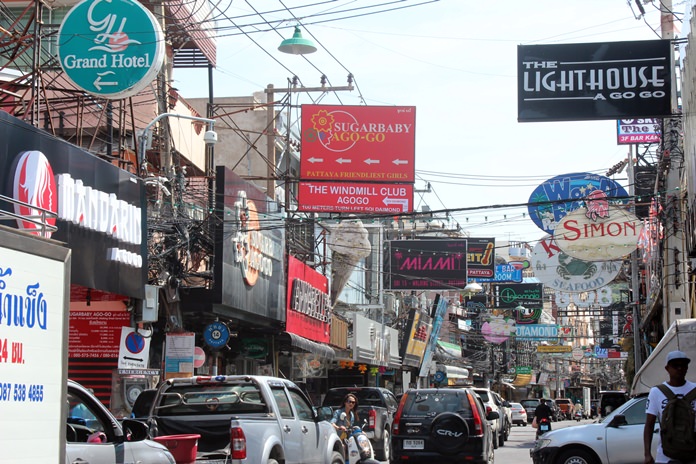
PATTAYA – City Hall is scrambling to contain the fallout over its widely criticized proposal to remove all of Walking Street’s signature neon signs, a move suggested for safety reasons.
City officials barred reporters from attending an Aug. 7 follow-up meeting on the plan, a move apparently aimed at tamping down the bad publicity surrounding their idea after it was blasted by both business and tourism executives.
More than 100 business owners filed complaints with city hall Aug. 1 after Deputy Mayor Apichart Virapal signed an order demanding that all retail and advertising signs found to be “non-standard” or illegally erected be removed by Aug. 24, particularly those over public property and on rooftops.
Business owners called city’s claim that the signs posed obstacles for emergency vehicles spurious and said that, in fact, what officials were trying to do was turn off the bright lights that draw millions of people to the big city each year. Removing Walking Street’s neon would gut the tourism industry, they claimed.
Pattaya spokesman Pinit Maneerat hastily called a briefing with the media Aug. 2 to try to quell the uproar, but only made matters worse.
Pinit claimed 99 percent of Walking Street’s signage – a total of 145 signs – did not meet regulatory standards or exceeded size limits.
He claimed the order sprung from the March daytime fire at the Blue Sky Rock Street pub which fire trucks “had a hard time” reaching.
He added that Mayor Anan Charoenchasri believes all the signs hanging over Walking Street pose obstacles to emergency vehicles and should be removed. No mention was made of the low hanging wires that cause more problems for emergency vehicles, as the photo clearly shows.
Business owners scoffed at both Anan’s justification and reasoning, noting Blue Sky was near the mouth of Walking Street and was easily accessed, and that the city’s owns checks showed the neon signs were not a hazard.
In 2015, city hall conducted a test in which fire trucks were driven down the nightlife strip to see if they could pass without being obstructed. There were no significant issues with the signs, as most were 5.2 meters or higher.
The real reason for the order, critics claimed, was that Thailand’s military government is embarrassed by the nightlife industry and that Walking Street has featured in too many foreign press reports and television shows. If they turn off the lights, the government hopes the reporters will go away.
Instead, business leaders claimed, it will be the tourists that depart. Walking Street is the first stop on every Chinese and Korean group tour and a draw for social media shutterbugs from around the world.
While the bars draw many people inside, about 10 times as many people just stroll Walking Street to snap selfies or simply say they’ve been there.
Business owners also pointed out that the majority of signs are for restaurants, shops and other businesses that don’t have alcohol and dancing girls.
At the Aug. 2 press briefing, Pinit appeared to backpedal a bit, saying that perhaps what should happen is that the big, horizontal signs be changed to narrow, uniformly sized vertical signs styled after those in the nightlife districts of Tokyo or Seoul.
That idea likely was to be discussed at Monday’s meeting, but the press was shut out of the session, perhaps so city officials could try to reshape Pattaya’s most-popular tourist attraction out of the public eye.




